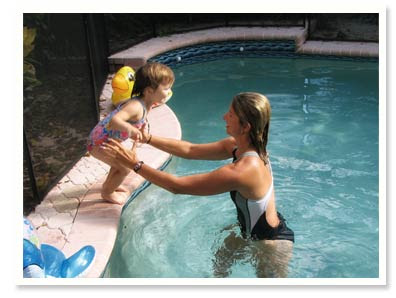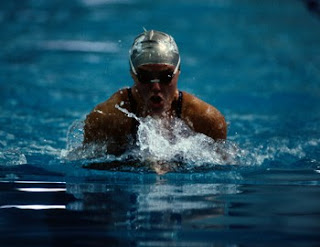Swimming is one of the most important and essential life skills but not everyone can do it. If you are a complete beginner and are intending to try out some of the swimming tips and exercises in this article, DO NOT go the swimming pool alone. Take a friend or relative with you in case you get yourself into trouble. Not only that, their moral support will help give you a boost.
Learning how to swim for some adults is a challenging and at the same time daunting experience. You may have a fear of water, you may have had a bad experience in the water as a child or you may even be embarrassed by the fact that you are not able to do what seemingly every other adult in the world can do.
All of these emotions cause tension and anxiety in our body, which in turn make breathing and basic movements more difficult than they really should be.
The key to learning to swim is to relax. Just relax and you will find floating and moving through the water much easier.
Ok, I know what you are thinking: "huh? Just relax he says. Like it is the easiest thing in the world. You want me to climb into the water, that thing I have a fear of, to learn a skill that quite frankly scares the life out of me and you expect me to 'just relax'? You have got to be kidding!"
No way. I do not expect relaxing in the water to come easily at all. However I can highlight to you some of the most common barriers preventing you from relaxing and holding you back from learning to swim.
Learning to swim in its most basic form is viewed as something that we do with our arms and legs in an attempt to remain afloat and move through the water. Whilst this is basically true there are some essential basics that are often overlooked.
Learn To Swim : Breathing
Breathing and submerging is usually the one key element that freaks out even the most determined beginner. This is perfectly natural. After all, we are humans not fish. We are not designed to be in the water and so we have to learn to change the way we breathe when we are in the water. Try these simple steps to learning how to breathe in the water.
- Hold onto the poolside, lower you chin to the water surface and blow bubbles. To some this seems like kids stuff but you will be surprised how many adults find this a challenge. Take in a huge lung full of air and then blow out in a slow and controlled way, letting the bubbles tickle your nose. If you are blowing then it is impossible to get water up your nose.
- Now try taking in a deep breath and holding it. No bubbles this time. Lower your mouth and nose into the water as much as you are comfortable with. Once again as long as you are holding your breath you will not get any water in your mouth or nose.
- For the next step you may want to wear some swimming goggles. Yes, you guessed it, lowering your whole face into the water. Wearing swim goggles will allow you to open your eyes under the water and see everything very clearly. No water will enter your eyes, providing your goggles are fitted correctly, and you will have a clear perception of where you are and what you are doing.
Learn To Swim : Floating
Lets deal with one of most common questions I get asked: 'how do I float?' Floating is a characteristic of your body, therefore you cannot learn how to float. Either you float or you do not. People with a higher body fat percentage tend to float well whilst those with a leaner and more muscular body composition will sink. That is not to say that if you do not float you cannot swim. Not at all. The momentum and movement of swimming will assist your body in remaining at or near the water surface.
Try floating in a star shape, with arms and legs open wide, either face up (supine) or face down (prone) - you may need your assistant to help support you to begin with here. The wide body shape will help even the poorest floaters remain at the water surface for a short time. This exercise will give you a good idea your body's own buoyancy and how it behaves in the water.
Learn To Swim : Standing up
Learning how to swim is one thing but how do you stop and stand up again in the water mid swim when that fear suddenly kicks in again? Standing up from a face down position is rather like sitting in a chair that has been placed behind you. You will need you arms to help assist your legs down to the pool floor.
Pull down through the water with both hands and arms and at the same time bend your knees up underneath you. Now sit up in the water and place your feet on the pool floor.
The most common mistake is to lift the head and arch the back in an attempt to make the legs sink, without bending the knees at all.
Now put these three key elements together. Take a deep breath, place your face in the water and adopt the star shape floating position. When you have held your breath and floated for long enough (try 10 seconds), then slowly bend your knees and stand up again.
The more you practice this exercise and each element of it the more you will learn how to relax in the water.
You have just taken the first steps to not only learning how to swim, but to conquering your fear of the water and achieving one of the most important life skills. Now it is a case of adding the arm and leg movements, depending on which swimming stroke you wish to learn.
You will meet some challenges along the way as those fears sometime creep back and remind you, but Rome was not built in a day. Practice and determination will see you though.
Good luck!





























